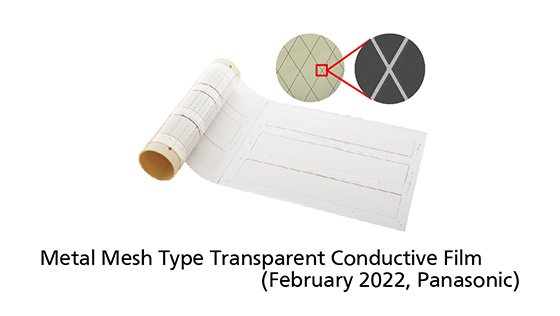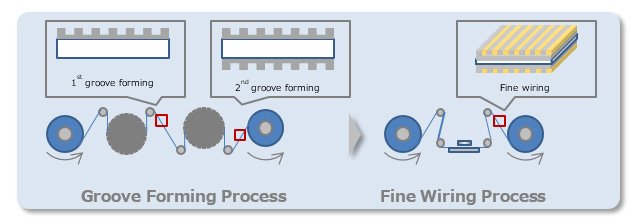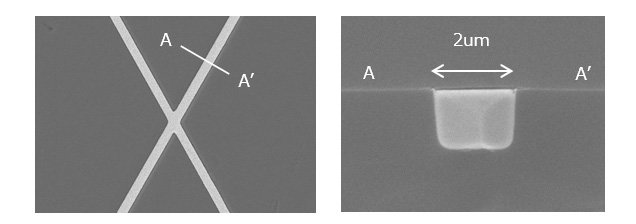
Nov 18, 2025
- Products & Solutions
- Stories
- Operating Company
Feb 16, 2022
Products & Solutions / Press Releases
The industry's first*1 "roll-to-roll construction method" developed by the company is used to implement double-sided full wiring

Osaka, Japan – Panasonic Corporation announced today that its Industry Company has commercialized a double-sided full wiring transparent conductive film combining low resistance and high transmissivity, using its unique roll-to-roll construction method for the first time in the industry.
Recently, touch displays with a higher image quality and larger size require a transparent conductive film with improved properties, which has led to the on-going development of a metal mesh [1]. The ordinary etching method for manufacturing a metal mesh allows the production of a metal mesh with a larger size and lower resistance, but poses a problem whereby the wiring in the metal mesh is visible. Panasonic's original roll-to-roll construction method has achieved a wiring width of 2 μm, which was difficult to attain with conventional etching methods, and also achieved a high aspect ratio [2], thus offering a transparent conductive film combining low resistance and high transmissivity. In addition, this method allows full wiring on both surfaces of the film, thus achieving high coordinate accuracy and the use of fewer materials. The newly developed film will meet customers' needs for a touch display with a higher image quality, larger size, and reduced environmental impact.
In-vehicle displays, touch sensors for consumer use, transparent antennas, back planes of transparent displays, transparent heaters, etc.
As the need for a touch display with a higher image quality and larger size increases, a touch sensor placed on the display is required to maintain its touch function while maintaining the high image quality. Against this background, a transparent conductive film, which makes up the touch sensor, requires both low resistance and high transmissivity. However, with the ordinary etching method for manufacturing a metal mesh, there is a trade-off between low resistance and fine wiring. It achieves low resistance, but requires a greater wiring width, resulting in insufficient transmissivity. Meanwhile, by adopting its original roll-to-roll construction method, Panasonic has succeeded in forming a wiring pattern with a high aspect ratio that reduces the wiring width to 2 μm, which was difficult to achieve with conventional etching methods, thus developing a transparent conductive film combining low resistance and high transmissivity.
This technology enables the manufacturing of a touch display with a higher image quality and larger size, and contributes to development of a design-free transparent antenna utilizing transparency.

Fig. 1 Panasonic's original roll-to-roll construction method

Fig. 2 Electron microscope photos showing the surface and cross-section of a wiring line manufactured by the original construction method
Conventional capacitive touch sensors are manufactured by laminating together two films, one for the transmission electrode and the other for the reception electrode. This manufacturing method has a problem whereby the positional accuracy of both electrodes depends on the mechanical precision of the laminating device and the viscosity of the adhesive. Panasonic, on the other hand, has formed the transmission and reception electrodes on the front and back surfaces of a single film through double-sided full wiring patterning by using the company's original roll-to-roll construction method, thus succeeding in significantly improving the relative positional accuracy of the electrodes. Panasonic's method makes the device thinner, improving its bendability to make it more flexible.
Panasonic's transparent conductive film allows fine wiring, thus achieving a high aperture ratio [3]. This increases the transmissivity of light emitted from the display, allowing the transparent conductive film to reduce its power consumption by about 4%, compared with a conventional transparent conductive film manufactured by an ordinary etching method, when both films are incorporated in displays with the same area and resolution.
In addition, by forming the transmission and reception electrodes on the front and back surfaces of a single film through double-sided full wiring patterning, a touch sensor can be created using one film, instead of two as is usually the case, thereby contributing to a reduction in environmental impact.
Table 1. Specifications
| Product name | Transparent conductive film | ||
|---|---|---|---|
| Wiring line | Width | 2.0 μm | |
| Thickness | 1.5 μm | ||
| Transmissivity | 94% | ||
| Sheet resistance | 2 Ω/sq. | ||
| Frame wiring L/S[4] | 8/8 μm | ||
| Base material | PET, PC, COP | ||
| Bendability | ≧R2 mm | ||
Electromechanical Control Business Division, Industry Company, Panasonic Corporation
https://www3.panasonic.biz/ac/e/user/new_question/index.jsp?ad=press20220216
https://ac-blog.panasonic.com/en/control/touch-panels/metal_mesh/special?ad=press20220216
Panasonic Corporation Corporate PR Center
https://news.panasonic.com/global/contacts/
Panasonic Corporation is a global leader developing innovative technologies and solutions for wide-ranging applications in the consumer electronics, housing, automotive, and B2B sectors. The company, which celebrated its 100th anniversary in 2018, operates 522 subsidiaries and 69 associated companies worldwide and reported consolidated net sales of 6,698.8 billion yen for the year ended March 31, 2021. Committed to pursuing new value through collaborative innovation, the company uses its technologies to create a better life and a better world for customers. Learn more about Panasonic: https://www.panasonic.com/global.
The content in this website is accurate at the time of publication but may be subject to change without notice.
Please note therefore that these documents may not always contain the most up-to-date information.
Please note that German, Spanish and Chinese versions are machine translations, so the quality and accuracy may vary.